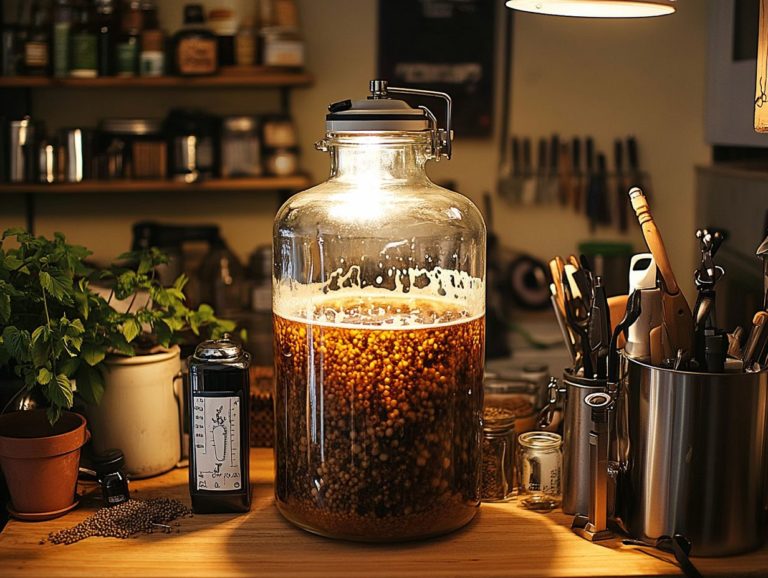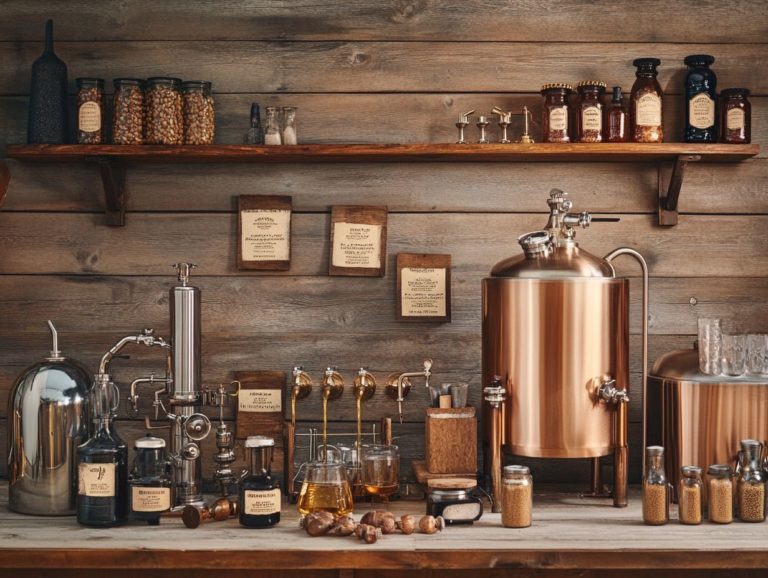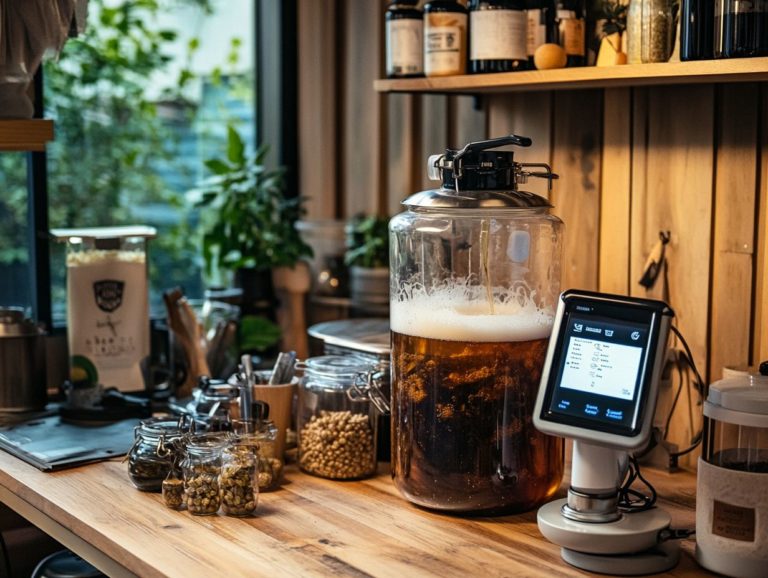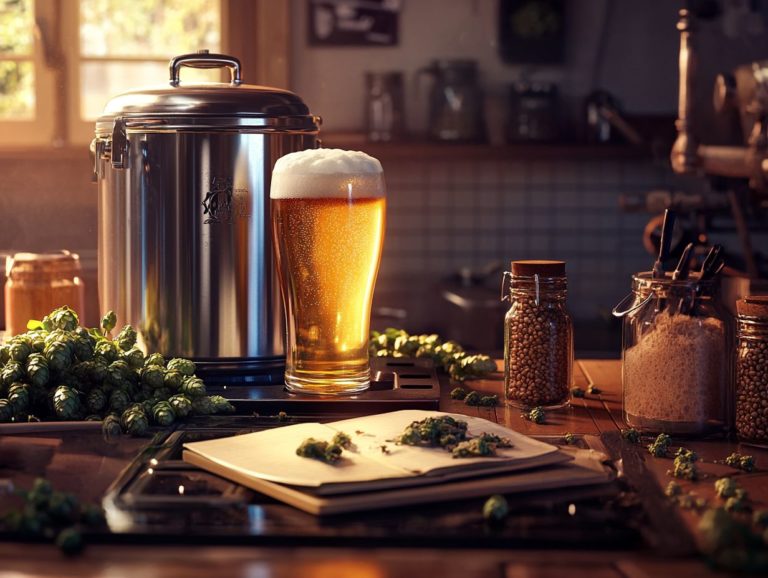How to Conduct a Home Brewing Experiment
Contents
- Home Brewing: A Creative Journey
- Key Takeaways:
- What is Home Brewing?
- Why Conduct a Home Brewing Experiment?
- Choosing Your Home Brewing Experiment Topic
- Setting Up Your Home Brewing Experiment
- Home Brewing Essentials
- Conducting Your Home Brewing Experiment
- Analyzing and Interpreting Your Brewing Results
- Frequently Asked Questions
- What supplies do I need to conduct a homebrew experiment?
- What is the first step to conducting a homebrew experiment?
- Can I use any type of water for my homebrew experiment?
- Do I need to use a specific type of yeast for my homebrew experiment?
- How long does a homebrew experiment typically take?
- Do I need any special equipment to conduct a homebrew experiment?
Home Brewing: A Creative Journey
Home brewing is an exhilarating and fulfilling hobby that empowers you to create your own distinct beers, ciders, and various other beverages from the comfort of your home.
Whether you’re just starting out or already have some brewing experience under your belt, engaging in a home brewing experiment can significantly enhance your skills and deepen your understanding of the brewing process.
This guide will walk you through the different methods of home brewing, highlight the benefits and potential risks of experimentation, and outline crucial considerations for setting up and evaluating your brewing projects.
Join us on this exciting journey into the world of home brewing!
Key Takeaways:
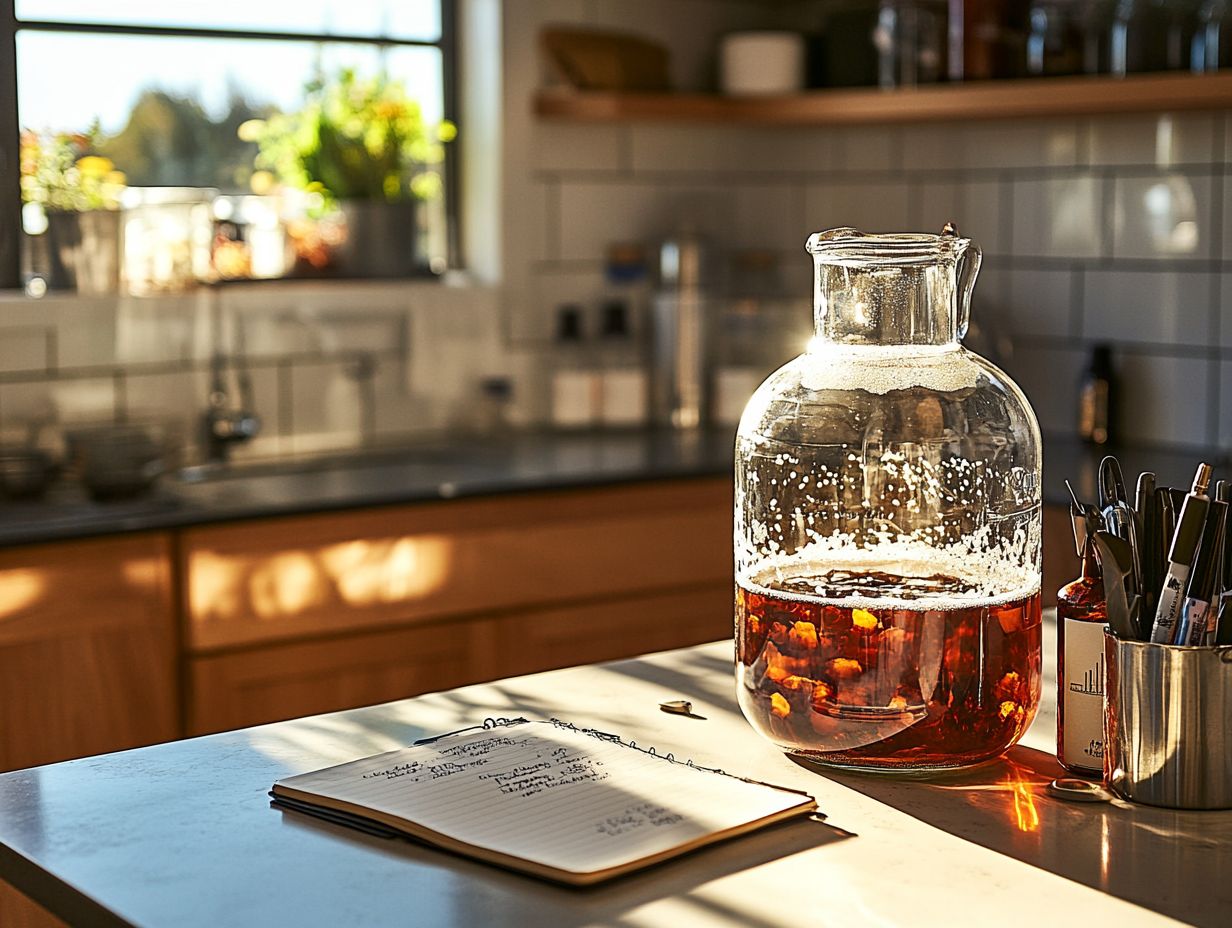
- Conducting a home brewing experiment allows for experimentation and improvement of brewing skills.
- When choosing a home brewing experiment, consider factors such as equipment, ingredients, and potential risks.
- To effectively analyze and interpret results, follow best practices and use the findings to enhance your brewing techniques.
What is Home Brewing?
Home brewing is the exquisite blend of art and science that lets you craft your own beer right at home. This gives you the freedom to explore a fascinating array of flavors and techniques.
This practice has become increasingly popular among beer aficionados eager to experiment with various ingredients like hops, yeast, and malt.
By diving into the brewing process from primary fermentation to that delightful moment of carbonation you have the opportunity to produce craft beers that align perfectly with your personal palate.
Whether you opt for a straightforward brewing kit or invest in advanced equipment, the exhilarating journey of brewing beer is anchored in your creativity and passion for quality.
What are the Different Methods of Home Brewing?
You can explore a variety of home brewing methods, including extract brewing, all-grain brewing, and partial mash brewing.
Each method offers its own level of complexity and equipment requirements, enabling you to select the approach that aligns best with your skills and the tools at your disposal.
If you’re just starting out, extract brewing is a fantastic option. It requires minimal equipment typically just a kettle, fermentation vessel, and some basic sanitization tools.
This makes it the perfect entry point for novices like yourself.
On the other hand, all-grain brewing demands a bit more. You ll need additional equipment, such as a mash tun, and a deeper understanding of the brewing process.
This might feel a bit overwhelming at first, but it allows for a greater degree of customization and often yields rich, complex flavors.
Then there’s partial mash brewing, which offers a pleasing middle ground.
By combining grains with extracts, this method caters to both novice and more experienced brewers alike.
No matter which path you choose, styles like IPAs, stouts, and lagers are within your reach, offering you the chance to experiment and refine your brewing skills over time.
Why Conduct a Home Brewing Experiment?
Engaging in a home brewing experiment invites you to immerse yourself in the intricate art of brewing.
This provides an opportunity to explore new flavor combinations and elevate your techniques.
By experimenting with diverse ingredients such as hops, malt, and distinctive adjuncts like fruits and spices, you can uncover innovative recipes that cater to your personal taste preferences.
This journey of experimentation promotes learning through trial and error, yielding gratifying victories in flavor development and a more profound understanding of the fermentation process.
Sharing your results with fellow home brewers enhances community engagement and facilitates a rich exchange of knowledge.
Now that you understand the basics, it s time to unleash your creativity and start brewing your own unique beverages!
What are the Benefits of Conducting a Home Brewing Experiment?
Conducting your own homebrewing experiments opens up a world of benefits, from discovering enhanced flavors to honing your brewing skills. As you experiment with ingredients like Cascade hops and Wyeast 1056 yeast, you’ll create unique recipes that not only expand your palate but also deepen your understanding of various beer styles.
This hands-on approach enables you to dive into important brewing concepts such as the temperature at which the fermentation occurs and original gravity. You’ll also nurture your creative flair in the brewing process. Sharing your successful experiments with the homebrewing community builds connections and fosters a culture of collective learning.
Engaging in homebrewing brings personal satisfaction that stems from crafting something entirely from scratch, perfectly suited to your taste preferences. Every batch is an exciting opportunity to sharpen your brewing skills and tackle fresh challenges, significantly enhancing your skills.
As you share your unique creations, you become part of a vibrant community, sparking lively discussions and camaraderie with fellow enthusiasts. This collaborative spirit encourages a rich exchange of knowledge, allowing you to develop signature recipes that you can proudly call your own.
Ultimately, the journey of homebrewing is about personal growth and community involvement, as much as it is about the delicious final product.
Understanding the Risks of Home Brewing
Engaging in homebrewing experiments can be incredibly rewarding, but it’s essential to be mindful of certain risks that come along with the journey. Contamination stands out as one of the most significant threats, as improper cleaning and sanitation of your brewing equipment can lead to off-flavors and spoilage, ultimately compromising your final product.
You might also face fermentation challenges, like stuck fermentation or undesirable flavors stemming from incorrect yeast selections or fermentation temperatures. Grasping these risks is vital for ensuring both safety and quality in your brewing endeavors.
The homebrewing process requires you to carefully monitor various factors, including pH levels, oxygen exposure, and the proper storage of ingredients, all of which can greatly influence your brewing outcome. Safety concerns are equally critical, especially when working with high temperatures and the potential for pressure buildup in sealed containers. Without the right precautions, you could face risks of injury or even explosions.
As you experiment with different recipes and brewing methods, it’s crucial to stay vigilant and educated about these potential pitfalls. This knowledge will not only enhance your brewing experience but also ensure that you enjoy a successful and fulfilling hobby.
Choosing Your Home Brewing Experiment Topic
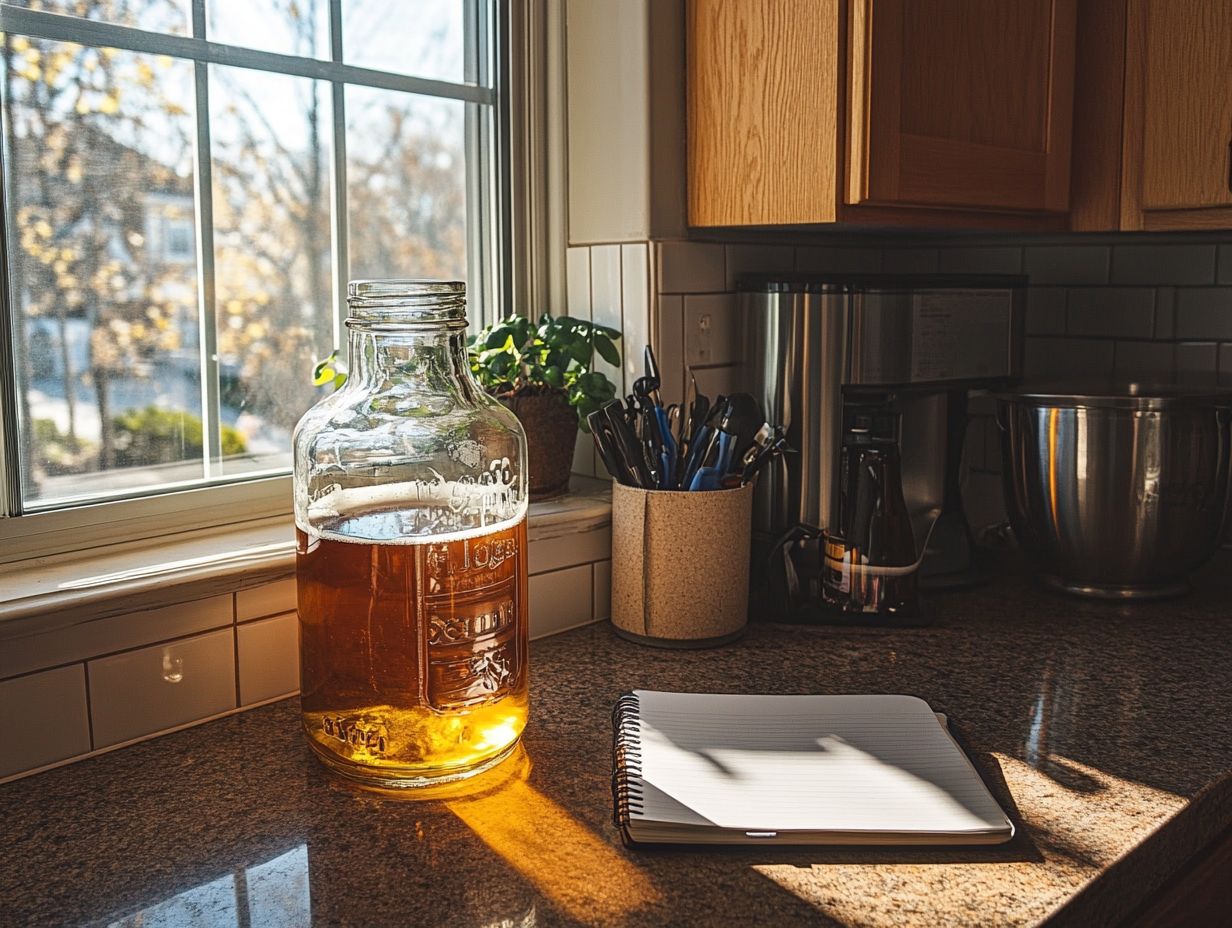
Selecting the perfect topic for your homebrewing experiment is crucial to crafting a successful and enjoyable brewing experience. As you make this decision, take into account the flavors you wish to explore, the ingredients at your disposal, and your personal goals as a home brewer.
Whether your ambition is to create an innovative watermelon wheat beer or to experiment with various hops for a fresh craft brew, honing in on your focus will streamline your research and experimentation. Exploring popular beer styles and current trends can inspire your brewing.
Ready to embark on your home brewing adventure? Let s get started!
What Factors Should You Consider When Choosing a Home Brewing Experiment Topic?
When selecting a topic for your home brewing experiment, there are several key factors to consider to ensure your success. Start by thinking about the ingredients you currently have or can easily source, as this will shape your recipe choices. Next, reflect on your target audience are you brewing for yourself, your friends, or perhaps a competition? Understanding their preferences will allow you to fine-tune your flavors and styles accordingly.
Researching current beer styles and popular trends in the home brewing community can ignite your creativity and provide the inspiration you need for your project. Don’t overlook the benefits of seasonal ingredients; fresh fruits in summer or aromatic spices in winter can truly elevate your brew.
The beauty of home brewing lies in its experimental nature, so embrace innovation! Feel free to blend flavors or adopt unconventional methods to craft unique libations that stand out. Participating in local brewing groups or online forums can also be a treasure trove of insights and feedback, enriching your brewing experience.
By remaining mindful of your resources and the ever-evolving tastes of beer enthusiasts, you position yourself to create a brew that resonates with a wider audience. This thoughtful approach not only makes the brewing process enjoyable but also rewarding in the end.
What Are Some Popular Home Brewing Experiment Topics?
Regarding home brewing, you ll likely find yourself drawn to exciting experiment topics that revolve around unique flavor profiles and innovative ingredient variations that tantalize the taste buds.
Many home brewers enjoy the thrill of creating fruit beers, experimenting with ingredients like apple or watermelon, which can yield refreshingly delightful results. Specialty styles such as Belgian wheat or American wheat ales provide a perfect canvas to explore the different flavors that yeast can create and fermentation processes.
When you play with different hop varieties, like Cascade or Cluster, you can significantly influence both the aroma and bitterness of your final product.
You’ll discover a thrilling world of spices and herbs, skillfully combining ingredients like coriander or basil to craft intriguing flavor notes. There s also a growing allure in barrel-aging your home brews; using various types of wood, such as oak, can impart distinct characteristics that add depth and complexity to stouts or porters.
For those of you with a taste for adventure, blending beers with contrasting profiles imagine a crisp lager mixed with a bold IPA can lead to fascinating new brews. Each of these experiments not only sharpens your brewing skills but also offers a splendid opportunity to share your unique creations with family and friends.
Setting Up Your Home Brewing Experiment
Setting up your home brewing experiment involves meticulous planning and preparation to guarantee a seamless brewing experience. Start by collecting all the essential brewing equipment, including a carboy for fermentation, a comprehensive brewing kit, and cleaning supplies to uphold sanitation standards.
Next, make sure you have the right ingredients ready at hand, such as malt, hops, yeast, and any additional flavoring agents you wish to incorporate. Familiarizing yourself with the brewing process, from mashing to bottling, will not only streamline your setup but also elevate the overall quality of your beer.
Now is the time to get started on your brewing journey! Share your experiences and connect with fellow enthusiasts to enhance your skills and creativity.
Home Brewing Essentials
What Equipment Do You Need?
To embark on a successful home brewing adventure, you’ll need to gather an array of essential brewing equipment. At the heart of your setup is the fermentation vessel often a carboy or fermenter crucial for both primary and secondary fermentation.
A brewing kit simplifies your journey, providing many of the necessary tools like airlocks, hydrometers, and bottles. Cleanliness is paramount in brewing; sanitizing your equipment is crucial to ensure your beer is pure and delicious!
Other important tools include a kettle for boiling your ingredients, ideally made of stainless steel to avoid any off-flavors. A reliable thermometer helps you monitor temperatures throughout the brewing process, while a siphon or racking cane allows for effortless transfer of beer from one vessel to another without disturbing the sediment.
Keep measuring cups and spoons close at hand for precision in your recipes, ensuring that each batch aligns perfectly with your taste expectations. Lastly, invest in a quality beer capper; it’s essential for sealing your finished bottles securely, preserving the flavors and carbonation you’ve worked so diligently to achieve.
What Ingredients Do You Need?
Gathering the right ingredients is essential for your home brewing experiment, as they play a pivotal role in shaping the flavor and quality of your beer. The primary ingredients include malt, which provides sugars that yeast can turn into alcohol; hops, contributing bitterness and aroma; and yeast, responsible for fermentation. Don t overlook the importance of quality water, as it constitutes the majority of your beer’s composition. You might also consider incorporating adjuncts like fruits, spices, or specialty grains to elevate your recipe and craft unique flavor profiles.
When selecting malt, choose fresh, high-quality varieties that align with your desired beer style. Take the time to understand how different malts such as caramel or roasted can influence the flavor. Hops should be selected with care, paying attention to their alpha acid content for bitterness and their aromatic qualities, which can create complex profiles based on the variety and timing of their addition during brewing.
Yeast selection is equally crucial; different strains can impart distinct flavors and aromas, significantly affecting the final product. For water, aim for a profile that complements your beer style. Consider adjusting the mineral content to fine-tune the taste. As for adjuncts, experiment cautiously, striking a balance between traditional flavors and creative additions for an exciting twist.
What Are the Steps to Setting Up Your Home Brewing Experiment?
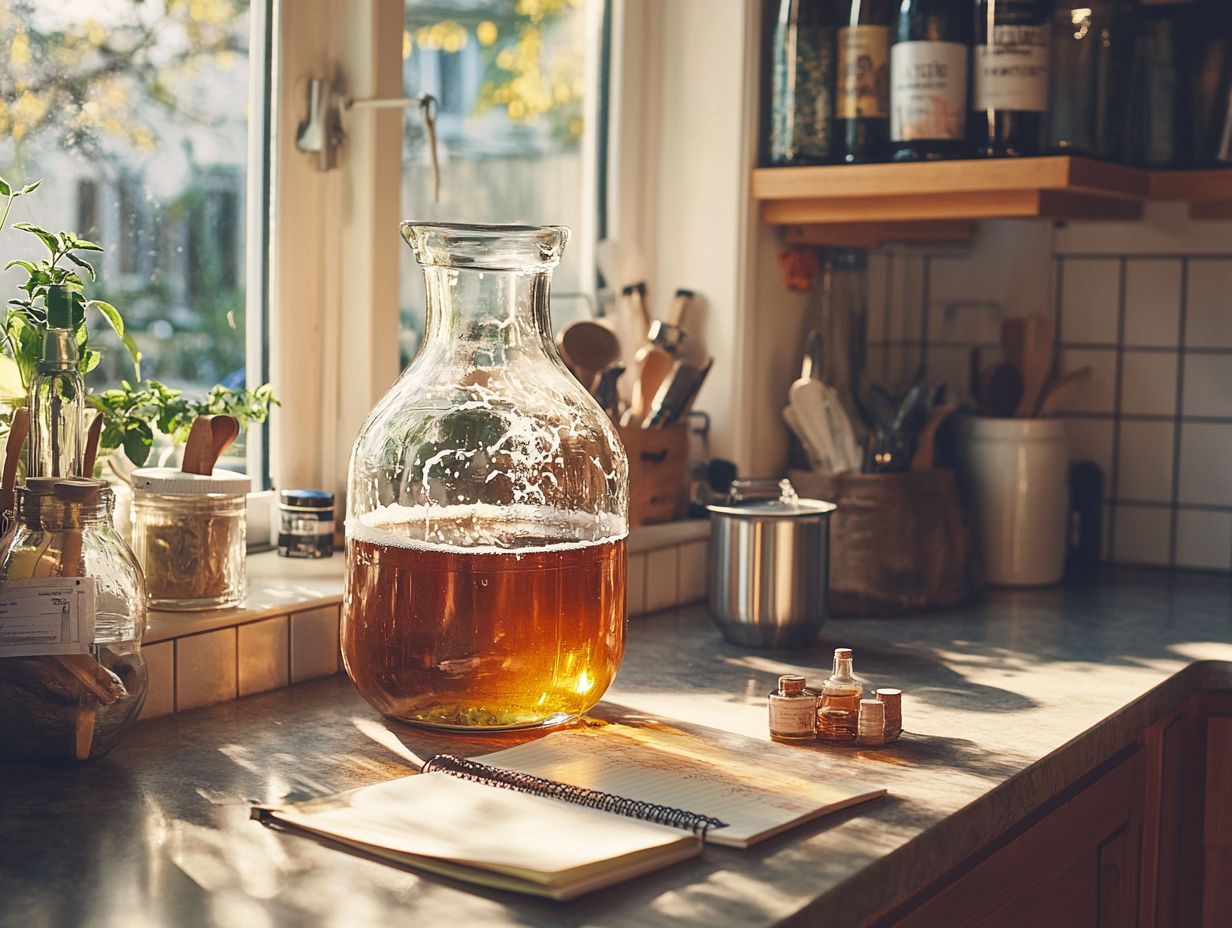
Setting up your home brewing experiment requires a systematic approach to ensure that you produce the best possible beer. Start by thoroughly cleaning and sanitizing all your equipment; proper sanitation is crucial to prevent any unwanted contamination during brewing.
Next, adhere to the guidelines of your chosen recipe, which includes mashing the grains, boiling the wort, and adding hops at precise intervals. Once the wort has cooled, transfer it to the fermentation vessel, add the yeast, and vigilantly monitor the fermentation temperature to achieve optimal results.
Utilize a no-rinse sanitizer for your equipment to save time while ensuring everything remains free of unwanted microbes. Pay close attention to the mash temperature, as it plays a significant role in the fermentation process and influences the final flavor and alcohol content of your beer.
During the boil, maintaining the correct temperature and timing for hop additions will not only contribute to the beer’s bitterness but also enhance its aroma.
After transferring the wort, carefully pitch the yeast, which will kick off the fermentation process, transforming sugars into alcohol. Throughout this journey, keeping a detailed log of every step you take can help refine your future batches, ensuring ongoing improvement and consistency in your home brewing endeavors.
Conducting Your Home Brewing Experiment
Engaging in your home brewing experiment requires you to meticulously monitor the key factors that dictate both the brewing process and the end result. Essential elements to pay attention to include fermentation temperature and the timing of hop additions.
These insights are vital for ensuring a successful fermentation and achieving the flavors you desire. Prepare to tackle challenges like stuck fermentation or unexpected off-flavors, as these issues can significantly affect the overall quality of your beer.
By grasping these factors, you will refine your brewing techniques and consistently produce superior batches over time.
What Are the Key Factors to Monitor During Your Experiment?
During your home brewing experiment, several key factors are critical for you to monitor if you want to achieve the best outcomes. First and foremost, keep the fermentation temperature within the specific range that suits your yeast strain; this aspect greatly influences the flavor development.
Track the initial sugar content measurements and final gravity readings to gauge the fermentation’s progress and pinpoint the beer’s alcohol content. Timing your hop additions will also significantly affect the beer’s bitterness and aroma, making it essential for achieving the intended flavor profile of your recipe.
Equally important is the pH level of the wort, which can impact enzyme activity and, consequently, the efficiency of starch conversion. Maintaining a stable pH range is crucial for ensuring optimal fermentation, leading to a cleaner flavor.
Don’t overlook the oxygen levels either; excessive oxygen can cause unpleasant off-flavors, while insufficient levels can compromise yeast health. Throughout the brewing process, practice rigorous sanitation, as any contamination could jeopardize the entire batch.
Each of these factors works in harmony to define your beer’s character. By paying careful attention to detail, you can ensure a truly successful brewing endeavor.
What Are Some Common Challenges You May Encounter?
On your thrilling brewing journey, get ready to tackle common challenges that could impact the quality of your beer.
One frequent issue is stuck fermentation, where the yeast seems to throw in the towel and fails to convert sugars into alcohol. This can happen due to temperature fluctuations or a lack of nutrients. Off-flavors might also creep in, often stemming from improper cleaning practices, incorrect fermentation temperatures, or the use of stale ingredients. Understanding these challenges and their underlying causes is essential for refining your brewing skills and achieving superior results in future batches.
You may also face other hurdles, such as a rushed carbonation process. If you’re not careful, your bottles could become overly pressurized, leading to spillage or, in some unfortunate cases, exploding bottles. This often results from insufficient fermentation time or an accidental overdose of priming sugar.
Clarity issues may also arise, with cloudiness detracting from your beer s final presentation. Regular cold crashing can be an effective remedy for this. Using proper cleaning techniques and brewing equipment is essential to prevent such issues.
By pinpointing each problem’s root cause and applying thoughtful, strategic solutions, you can elevate your brewing process, transforming setbacks into valuable learning experiences that will ultimately enhance your homebrew and craft.
Analyzing and Interpreting Your Brewing Results
Analyzing and interpreting the results of your home brewing experiment is crucial for grasping the effectiveness of your techniques and evaluating the quality of your beer. Once fermentation and carbonation have completed, conducting a meticulous tasting allows you to assess the flavor, aroma, and mouthfeel of your creation.
It’s essential to consider various beer styles and how your brew aligns with those standards. Seeking feedback from fellow home brewers or beer judges can provide invaluable insights into areas that may need improvement, helping you refine your recipes for future batches.
Maintaining detailed notes throughout the brewing process will assist in this analysis and serve as a guide for your upcoming experiments. Engaging with brewing books and recipes online can also provide valuable information for perfecting your craft.
Now that you’re aware of these challenges, what strategies will you implement in your next brew?
What Are the Best Practices for Analyzing Your Results?
To effectively analyze your brewing results, it’s essential to embrace best practices that deepen your understanding of the final product. Start by conducting structured tastings, concentrating on specific attributes such as aroma, flavor, and mouthfeel for a well-rounded evaluation. Gathering feedback from seasoned home brewers or BJCP judges can provide invaluable insights into how your beer measures up against established styles and expectations. By keeping detailed brewing notes and observations throughout your brewing process, you can identify what worked and what didn t, paving the way for continuous improvement. Consider using different yeast strains like Wyeast 1056 or Safale US-05 to experiment with diverse flavors.
Integrating these practices not only enhances your sensory experience but also helps you uncover subtle nuances that might slip by without careful analysis. Engaging your peers in tasting sessions fosters a collaborative atmosphere where diverse perspectives can enrich your understanding of the brewing outcomes. Using hops such as Cascade or Willamette can introduce interesting flavors to your brew.
Recognizing the importance of documentation especially when competitors are crafting similar beers allows you to track changes over time, spot patterns in your brewing process, and make informed adjustments. By prioritizing consistent feedback and thorough documentation, you can refine your technique, ultimately leading to exceptional brews that align with both your personal standards and community expectations. Additionally, using ingredients like honey malt and light malt extract can enhance the flavor profile of your beer.
How Can You Use Your Results to Improve Your Home Brewing Skills?
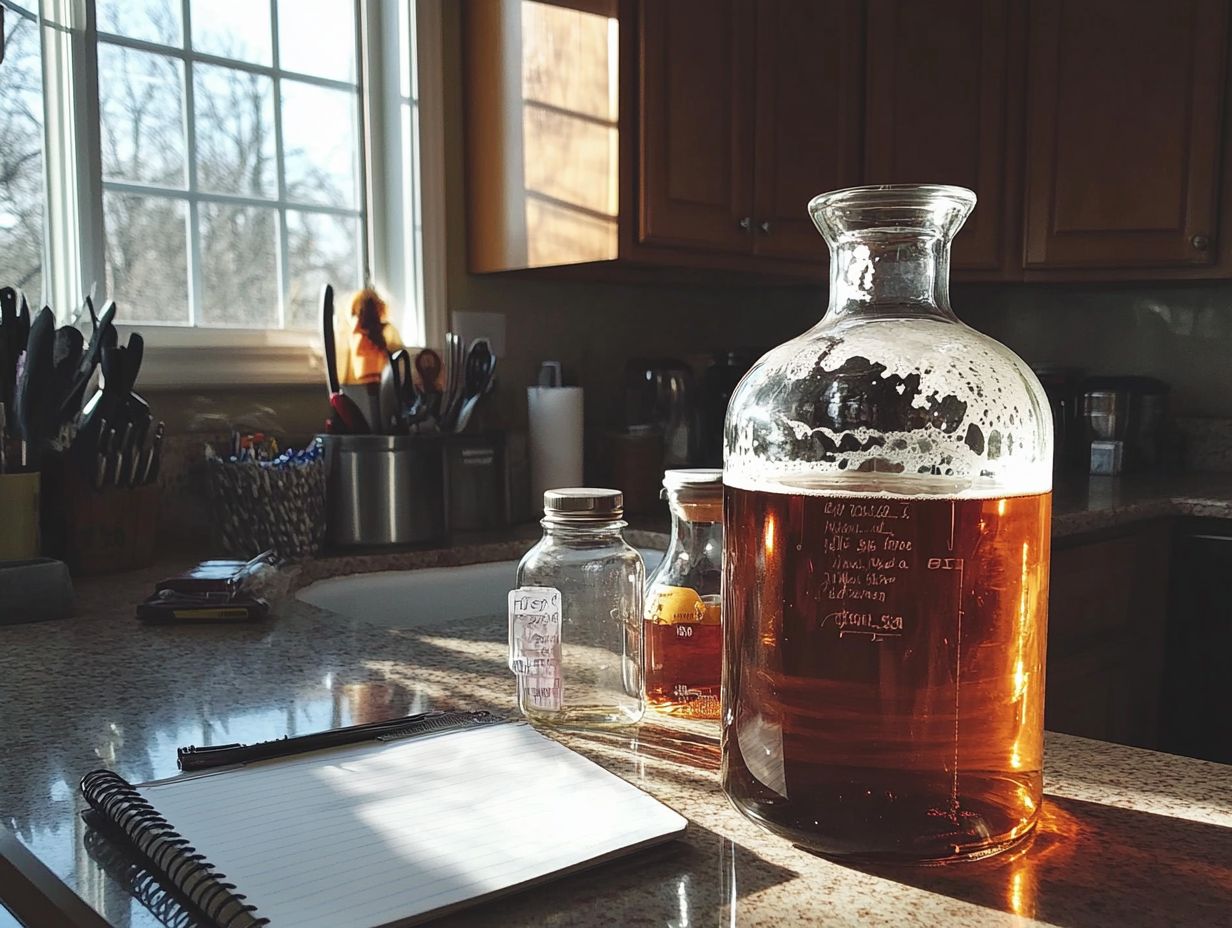
Utilizing the results of your home brewing experiments as a learning tool is essential for elevating your brewing skills. By carefully analyzing feedback and tasting notes, you can pinpoint specific areas for improvement, whether that means adjusting ingredient ratios or fine-tuning fermentation times. The insights gained from past experiments will be invaluable as you refine your techniques and deepen your understanding of flavor combinations and brewing processes. Embracing a mindset of continuous learning and adaptation is vital to becoming a more proficient home brewer. Get creative and whip up a refreshing watermelon wheat beer or experiment with innovative beer recipes.
Consider the impact of yeast strain selection on your final product. If your previous brew fell short in complexity, trying different yeast varieties like Belgian Wheat 3942 or Weihenstephen Weizen 3068 could lead to delightful surprises.
Keeping careful notes on each brew’s conditions such as temperature fluctuations during fermentation allows you to see how these variables influence taste. Pay attention to fermentation temperature and its impact on the flavor profile of your brew.
Engaging with other home brewers through forums or local clubs can also open the door to valuable insights, creating opportunities for shared tips and innovative methods to enhance your brewing routine. Learning from experienced brewers like Bryan Roth, Billy Broas, and Ted from Durham, North Carolina can provide fresh perspectives.
Applying these strategies will boost your brewing skills and allow you to enjoy the unique, flavorful outcomes of your craft. Consider making a cider with peppers for a touch of heat!
Frequently Asked Questions
What supplies do I need to conduct a homebrew experiment?
Here s what you need to start your home brewing adventure: a large pot, a thermometer, a funnel, a strainer, a fermentation vessel (like a carboy), an airlock, brewing yeast, malt extract, hops, and water.
What is the first step to conducting a homebrew experiment?
The first step is to thoroughly clean and sanitize all your brewing equipment to ensure a successful and safe brew.
Ready to dive into brewing? Share your experiences in the comments below!
Can I use any type of water for my homebrew experiment?
No, you should use filtered or distilled water. This helps avoid unwanted chemicals or minerals that can affect the taste of your brew.
Do I need to use a specific type of yeast for my homebrew experiment?
Yes, different yeast types produce various flavors and aromas. For an American wheat ale, try using Wyeast 1056.
How long does a homebrew experiment typically take?
Brewing usually takes 2-4 weeks, followed by 1-2 weeks for carbonation and conditioning. A brewing kit streamlines the entire process.
Do I need any special equipment to conduct a homebrew experiment?
You can start with just a large pot and a few basic supplies. However, investing in a good fermentation vessel, known as a carboy, can significantly enhance the quality of your brew.

